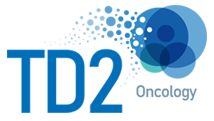Advancing Precision Oncology: Development and Utilization of Breast Cancer PDX Models for In Vivo Drug Discovery
Authors: Erin Trachet, Paul Gonzales, Stephen Gately; Translational Drug Development (TD2)

Abstract: Breast cancer is a highly heterogeneous disease that poses significant challenges for drug development and personalized treatment. Patient-derived xenograft (PDX) models have emerged as essential tools for preclinical research, faithfully preserving the genetic, transcriptomic, and histopathological features of primary tumors, including intratumoral heterogeneity and the tumor microenvironment. The Nature publication, "A human breast cancer-derived xenograft and organoid platform for drug discovery and precision oncology", highlights the utility of breast PDX models in advancing precision medicine and accelerating therapeutic discovery. Through a collaboration with the University of Utah, TD2 has developed three well-characterized in vivo breast cancer PDX models: HCI-015, HCI-043, and HCI-044. HCI-015 and HCI-043 are triple-negative breast cancer (TNBC) models, with HCI-015 harboring BRCA1 and BRCA2 deletions. HCI-044 is an estrogen receptor-positive (ER+), progesterone receptor-positive (PR+), and HER2-negative. These models were selected based on their organoid performance and clinically relevant drug responses. For example, HCI-015 was sensitive to docetaxel and a Notch inhibitor but refractory to navitoclax, while HCI-043 showed high sensitivity to eribulin. The ER+ HCI-044 demonstrated minimal dependence on estrogen supplementation, with growth maintained despite ovariectomy. To preserve tumor heterogeneity and the microenvironment, TD2 developed a low-passage tumor propagation process using orthotopic implantation into the fourth mammary fat pad via a surgical technique. Tumors in HCI-015 and HCI-043 established and grew progressively within 35 days, while HCI-044 required 60 days but maintained reliable growth. Pilot studies confirmed the reproducibility of tumor propagation and response profiles, supporting their use in efficacy testing. For efficacy evaluations, PDX tumors were implanted into female NSG or CIEA NOG mice, and therapeutic regimens were assessed. HCI-015 was highly sensitive to docetaxel, achieving 100% complete regression (CR), while tamoxifen treatment confirmed its ER-negative status, resulting in progressive disease (PD). Similarly, HCI-043 demonstrated 100% CR with carboplatin and eribulin. For the ER+/PR+ HCI-044 model, tamoxifen treatment resulted in PD, but eribulin achieved 100% CR, highlighting subtype-specific therapeutic responses. Despite their transformative potential, breast PDX models face limitations, including cost and incomplete human immune system representation. However, by optimizing these models and integrating patient history, researchers are advancing their fidelity and expanding their applications. These models bridge the gap between preclinical research and clinical outcomes, offering new opportunities to accelerate targeted therapy development and improve patient care.
Download Now
CONTACT US
Get Started.
Have questions about how TD2 can assist with your regulatory needs? Reach out to our expert staff today to get started.


